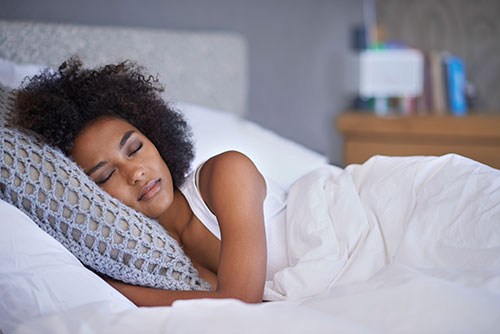Obstructive Sleep Apnea vs. Central Sleep Apnea
If you suffer from Sleep Apnea, you aren't alone. A staggering 20 million Americans suffer from this serious sleep disorder, a condition that causes sufferers to stop breathing up to hundreds of times each night while they slumber. However, most people don't realize that there are different kinds of Sleep Apnea, which may require slightly different treatment approaches.
Obstructive Sleep Apnea
Obstructive Sleep Apnea, or OSA, is the most common form of Sleep Apnea, affecting roughly 2% of women and 4% of men. OSA is caused by the partial or complete blockage of the throat tissues during sleep, cutting off your supply of oxygen. When this occurs, the sufferer's brain signals to the patient to partially awake to correct the problem. Patients find themselves gasping for air in the middle of the night, completely unaware of the problem. Unfortunately, once the patient is able to breathe, the brain returns the body to a normal sleep pattern, and the process starts again. Patients with mild Obstructive Sleep Apnea experience 5-14 episodes of breathing interruptions per hour, with severe cases reaching over 30 interruptions per hour.
Symptoms of Obstructive Sleep Apnea
-
Loud snoring
-
Waking up snorting, gasping, or feeling out of breath
-
Daytime fatigue
-
Depression and mood swings
-
Headaches in the morning
Risk Factors for Obstructive Sleep Apnea
-
Genetics: If your parents or grandparents suffer from OSA, you are more likely to suffer from OSA. This is due to the fact that physical characteristics of the mouth and throat, such as enlarged tonsils or a bigger tongue, can run in families.
-
Weight: Studies have shown that heavier people are more likely to suffer from OSA, because the fatty tissues around the neck and throat can put pressure on the airway and restrict airflow.
-
Age: As people age, they tend to lose muscle tone, even around the throat and neck. This can cause the muscles that prop open your airway at night to collapse, leading to OSA.
-
Drinking or Smoking: Smoking can inflame the tissues of the throat, causing to fluid buildup that can restrict airflow. Drinking causes the muscles of the body to relax, which can affect the throat muscles and impede your breathing.

While the two types of apnea produce similar symptoms, their causes and risk differ widely.
Request My Appointment
Central Sleep Apnea
Unlike Obstructive Sleep Apnea, which can be thought of as a mechanical condition, Central Sleep Apnea occurs when the brain doesn't trigger the "wake up" response immediately so that people start breathing again. CSA is often caused by other medical conditions, such as problems with the brain stem or cancers. However, because it occurs during sleep, CSA can go unnoticed for years if you don't know what to look for.
Signs of Central Sleep Apnea
-
Poor nighttime sleep, followed by daytime fatigue
-
Shortness of breath during sleep
-
Snoring (although the snoring might not be as loud or frequent as people who suffer from OSA)
-
Headaches
Risk Factors for Central Sleep Apnea
-
Gender and Age: Men are more likely to develop CSA than women are. Also, older individuals are more likely to develop CSA.
-
Certain Medications: If you take opioid medications, such as morphine, oxycodone, or codeine, you are more likely to suffer from Central Sleep Apnea.
-
Medical Conditions: If you suffer from Parkinson's Disease, heart disease, congestive heart failure, brain cancer, or you have had strokes in the past, you are at a higher risk for developing CSA.
-
Altitude: People can also develop CSA if they are visiting places with higher altitudes than they are used to. Fortunately, most patients report normal sleep when they return home.
Treatment for OSA And Central Sleep Apnea
Fortunately, both types of Sleep Apnea are treatable. Here are a few different treatment options that have been proven to be effective for Sleep Apnea patients.
-
Mandibular Advancement Devices: For people who suffer from mild to moderate OSA or CSA, Mandibular Advancement Devices have been shown to be effective. These mouth guards work by moving the lower jaw forward, which opens the airway and keeps patients breathing properly. Dr. Weyneth is an expert in oral appliance therapy for Sleep Apnea, and Sherman Oaks Dental has over 100 oral appliances to choose from.
-
Tongue Restraining Devices: Tongue restraining devices work by holding the tongue forward, so that it doesn't fall back into your throat and cut off your airway.
-
CPAP Machines: Continuous Positive Airway Pressure Machines, commonly called CPAP machines, deliver a steady stream of positive air pressure to the patient through a comfortable mask they wear during sleep.
-
Surgery: Patients with severe OSA might also find relief through surgery to reduce impeding tissues in the throat, such as the tonsils.
-
Medications: For Central Sleep Apnea, medications are often used to stimulate the brain during sleep.
If you are concerned about Sleep Apnea, make an appointment with your doctor today. If you are diagnosed, Dr. Weyneth can create a comfortable, custom oral appliance to help you to ward off Sleep Apnea — so that you can avoid the devastating side effects of this common condition.
Request My Appointment

